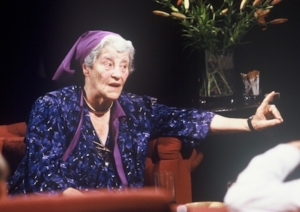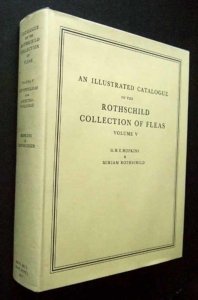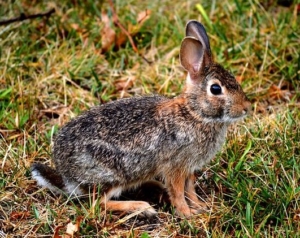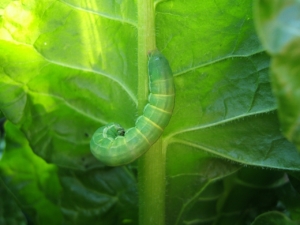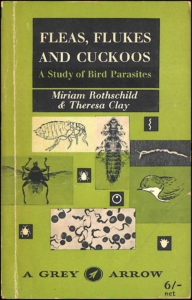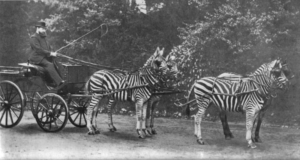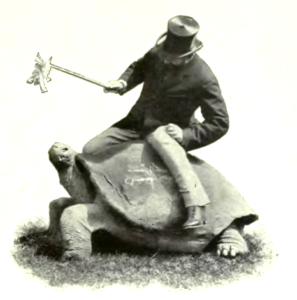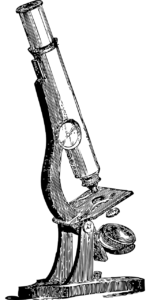Miriam Louisa Rothschild
Entomologist and Conservationist
Miriam Rothschild appearing on “After Dark”, 2 July 1988
Creative Commons Attribution-Share Alike 3.0 Unported
- BORN 5th August 1908, Ashton Wold, Northamptonshire, England
- DIED 20th January 2005, Ashton Wold, Northamptonshire, England
- WORKED Her home at Ashton Wold; Natural History Museum, London; Marine Biological Associations Lab, Plymouth Hoe; Bletchley Park (where she worked with Alan Turing to break the enigma code)
- HONOURS Elected as a fellow of the Royal Society, 1985; DBE (Dame Commander of the British Empire) 2000; Eight UK and European universities awarded her honorary doctorates; Elected a Foreign Honorary Member of the American Academy of Arts and Sciences, 1973; President of the Royal Entomological Society 1993-94; First woman to be a Trustee of the Natural History Museum, London, 1967
Entry by Peter Smithers, Fellow of the Royal Entomological Society
Podcast
In this podcast, Dr Patricia Fara (Science Historian and Emeritus Fellow of Clare College Cambridge) and Peter Smithers (Entomologist and Honorary Fellow of the Royal Entomological Society) discuss the life and work of Miriam Rothschild, an extraordinary scientist who started collecting butterflies and ladybirds when she was four and grew up to become one of the world’s leading entomologists. Insects often seem small and annoying, but they are crucial contributors to ecological diversity – and Miriam Rothschild was a pioneer in conservation who introduced wildflower meadows and launched the UK’s nature reserves. Her philanthropic activities included caring for Jewish refugees, founding an institute for research into schizophrenia and supporting Human Rights movements.
Artistic Connections
She was extremely interested in the arts and felt that science had become too sterile. Her book Butterfly Cooing Like a Dove is a wonderfully whimsical collection of writings that explore the way that the natural world has been imagined in art and literature.
Music
Title: In Miriam’s Wildflower Garden
Scientist: Miriam Rothschild
Composers: Year 3 Oak & Willow Classes, Thomas Hickman School
Words by: the composers
Written in: March 2022
For: Voices, piano, and sound effects
Performed by: the composers
Recorded: in the gardens of Waddesdon Manor, March 25th 2022
Film by: Herbie Clarke and the composers
This MEGASONG for Miriam Rothschild was created as part of the Voices for the Future: Miriam Rothschild project in collaboration with the Learning Team at Waddesdon Manor near Aylesbury. The children worked with Erika De Castro, Glennis Julian and Billie Pike, exploring the entomology and ecology of Miriam’s Wildflower Garden; created drawings of the stories of their chosen insects to use in the film; created the music with electric voice theatre and Bucks Music Trust musicians, and even designed a wildlife area with Ed Turpin from Bucks Wildlife Trust for their school.
Music by: Frances M Lynch
Words by: Frances M Lynch
Written in: 2016
For: mixed acapella voices
Performed by: The electric voice theatre Voices for the Future Virtual Choir and Young Singers Programme
The singers chant the names of six important UK women entomologists until their names can no longer be forgotten: Miriam Rothschild, Eva Crane, Eleanor Ormerod, Margaret Rae MacKay, Lucy Evelyn Cheeseman and Erica McAllister. You can find out more about them on this link
Title: Miriam
Music by: KAREN WIMHURST
Words by: Karen Wimhurst from the writings of Miriam Rothschild
Written in: 2013 in association with Peter Smithers, FRES, and Dr. Ruth Gilbert
For: Solo Voice and Bass Clarinet
Performed by: Frances M Lynch (voice) and Karen Wimhurst (bass clarinet)
First performance: Sept 2013, St Andrew’s University, Scotland, part of Ento ’13, the Royal Entomological Society International Symposium and Annual National Science Meeting
Miriam is as a small scale operatic work for two performers. Book ended by the formal gardens of childhood through to the wildflower and grass gardener of her latter years, the piece seeks to weave together her passionate and uniquely faceted life as scientist, campaigner and seeker of poetic truth into an impressionistic whole.
The libretto explores Miriam Rothschild’s life and just some of her achievements with words drawn from a range of her writing, including Animals and Man, Walter Rothschild (the Man, Museum and Menagerie), Butterfly Cooing like a Dove, The Rothschild Gardens, Fleas, Flukes and Cuckoos, Colour Atlas of Insect Tissue via the Flea as well as quotes drawn from Baroness Hannah Rothschild.
The music is divided into a number of interconnected sections:
INTRODUCTION (spoken) – to the physiology of the flea
FLEAS 1 – flea genesis and her father’s love
GARDEN 1 – the beautifully manicured Rothschild garden of eccentricity
FLEAS 2 – examining the tissue under a microscope
BUTTERFLIES – Uncle Walter, collections and classification
GARDEN 2 – her father’s death
FLEAS 3 – blood feeders
JUDENGASSE/ INHERITANCE – butterflies don’t live in the ghettos
ANIMALS AND MAN – a plea for compassion
FLEAS 4 – the jump
GARDEN 3 – a walk in the park….
GARDEN 4 – wildflower meadows
Education
No formal education, she was educated at home as her family felt that formal schooling was unsuitable for young ladies. As a teenager she attended evening classes in zoology at Chelsea college of science and technology.
Occupations
Entomologist
She worked as an independent biologist enlisting the best researchers from the UK and Europe to assist her. She was a world authority on the biology of fleas working on the mechanism of the fleas jump and the how rabbit fleas used hormones in their host’s blood to synchronise their breeding cycles.
Conservationist
She pioneered the restoration of wildflower meadows, helped in the initiation of the UKs National Parks. She has served on the National Trusts Committee for Conservation, the Society for the Promotion of Nature Reserves and the Royal Society for Nature Conservation.
Civil liberties activist
She fought to decriminalise homosexuality gathering scientific evidence for the Wolfenden Committee, who’s report finally led to decriminalisation.
Scientific Achievement
- Her Father had collected and described 500 new species of fleas. After her father’s death, Miriam catalogued and curated his collection of fleas adding many new specimens to it. This work – Illustrated Catalogue of the Rothschild Collection of Fleas vols 1 – 6 – still stands as one of the best accounts of the taxonomy of fleas and made Miriam a world authority on them.
- Using high speed film she worked out how the flea can jump so far.
- She also worked out how rabbit fleas syncronise their reproductive cycle with their host the rabbit by using the rabbits hormone as triggers for their own cycle.
- She was interested in the way that some caterpillars retained toxic chemicals from the plants that they ate and used them as a defence against potential predators. She realised that the main group of chemicals involved were pyrazines and spent her remaining career investigating how insects utilised them. In studying this relationship she invented the then new science of chemical ecology.
- Fleas, flukes and cuckoos was a popular science book that introduced the amazing world of parasites to the general reader
Did You Know?
She grew up surrounded by eccentricity, eg. Uncle Walter, who: –
- collected butterflies and had amassed a private museum of natural history at his home in Tring (now part of the Natural History Museum)
- kept giant tortoises on his lawn, and he and the children would ride on them
- is one of the few people to tame zebras and had a team pull his carriage which he used when visiting Buckingham palace.
- Miriam was a great campaigner against cruelty in farming and became a vegetarian who never wore leather shoes – even to the point of wearing white wellies under her dress when attending garden parties at Buckingham palace.
- She was devastated when her father committed suicide. She was just 15 and abandoned natural history for two years as a result. It was her brother who rekindled her interest, he came home from boarding school with a summer project to dissect and draw a frogs internal structures and he asked Miriam to help. She was fascinated by the complexity of what she saw and her interest in the natural world was re-ignited.
- Miriam worked at Plymouth Marine lab for 7 years studying marine molluscs and their parasites but all her research was lost when a German bomb destroyed the building her work was stored in.
- During WW2 Ashton Wold was used as a military hospital Miriam would often go shooting with recovering patients, one of which was Clark Gable, she said of him that he was a crack shot but had no sense of humour whatsoever.
- A few days before her death she summoned her scientific colleagues to her bedside to discuss the next steps in their research.
An Inspiring Woman
Miriam Rothschild’s financial independence enabled her to pursue anything that she found interesting and as she once said “I must say, I find everything interesting” so nothing was off her radar:-
- She sat on the committee that created the first UK National Parks
- Pioneered the restoration of wild flower meadows
- Was an active campaigner for gay rights
- Promoted the use of art therapy to treat mental health conditions.
- Founded the ‘Schizophrenia Research Fund’ in 1962 a charity that explored the use of art therapy in treating schizophrenia.
- She has influenced the way that we view the interactions between plants and insects, our understanding of host parasite relationships and the way we manage the countryside, in particular our wild flower meadows.
She once said:-
“Once you have a microscope, life is never long enough”
This epitomises her fascination and love of the natural world.

